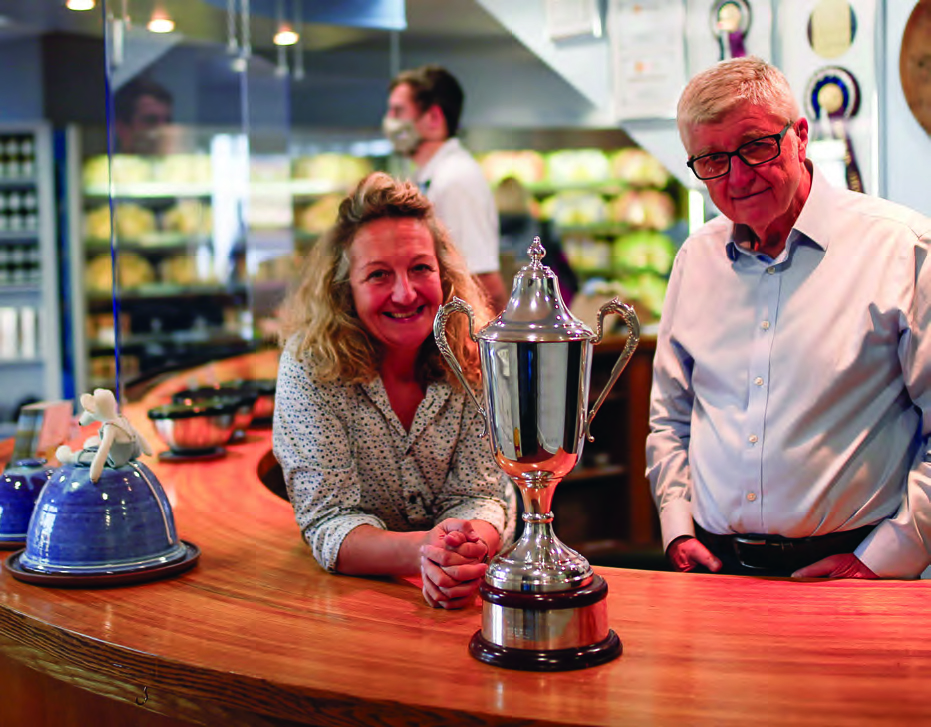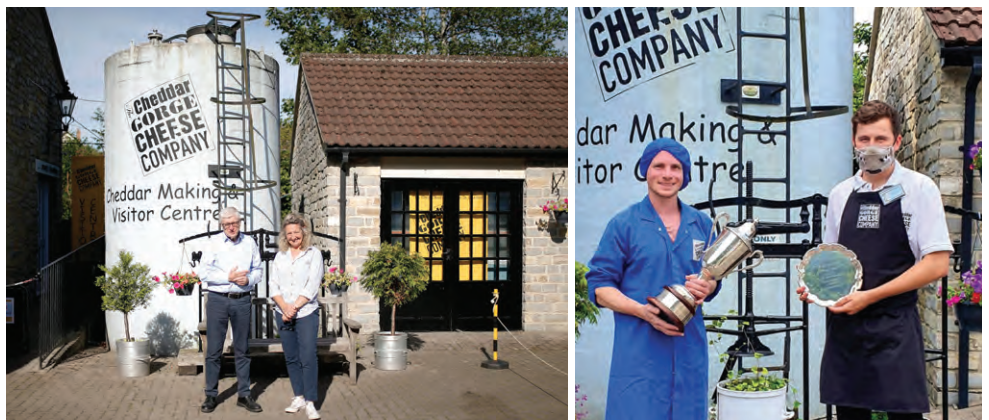
John and Katherine Spencer in their cheese shop
South West England is home to 11 areas of outstanding natural beauty, four UNESCO World Heritage Sites, two National Parks and has a feeling of remoteness and tranquillity, making the region a very popular holiday destination. A small village in Somerset is now trying to get itself added to this ambitious list and it is banking on its unique selling proposition to get there. It is home to the best-known British food export, the Cheddar cheese.
Cheddar the cheese
Originating from Cheddar, the eponymous cheese is relatively hard, off-white that is often sharp in taste. In the ancient period, it was made naturally.
On the edge of the village, Cheddar Gorge contains several caves, which provides ideal humidity and steady temperature for maturing the cheese. Production of Cheddar dates back to the 12th century. Legend says that in 1170, King Henry II reportedly bought 4,640 kg of cheddar cheese from the village at a farthing per pound. In the 17th century, King Charles I also reportedly bought cheese from here.
As per historians and cheese experts, the high quality and taste of the cheese caught the attention of wealthy attention Londoners who visited the renowned caves of Cheddar Gorge. They spread the word and the cheese became famous in the 15th century.
During Charles I’s reign from 1625-1649, the demand outweighed the supply, making it extremely expensive. The cheese was only available in his court. Even then for the cheese to be bought orders were placed well in advance.

Processed cheese stored in the inventory
By the mid-17th Century, London became England’s main cheese market. The cheese was in high demand putting the cheesemongers under tremendous pressure to increase the size of the wheels. The cheesemakers in Cheddar developed a process known as “cheddaring”, in which they pressed milled curds to reduce the liquid whey. Decreasing cheese’s moisture levels after scalding rendered it even more solid, making it easier to shape the cheddar into larger, longer-lasting wheels that could be transported to London and all over the country.
This development allowed the production of cheddar to be scaled up and industrialised. Apart from England, the United States of America became a major supplier of cheese which led to a decline in the industry there.
Even though cheddar was being created around the globe, the cheese was conventionally British. In 1840, Queen Victoria received a massive cheddar “drum” weighing 558 kg as a wedding gift. Royal Navy officer Robert Falcon Scott in 1901, for his expedition of Antarctica, took almost 1,600 kg of cheese with him onboard.
During the Second World War (1939 – 1945), most of the milk in Britain was used to make a single variety of cheese nicknamed “Government Cheddar” as part of war economy and rationing. This in turn resulted in almost wiping out production of all other kinds of cheese in the country. Before the First World War (1914-1918) more than 3,500 cheese producers were in Britain by the end of the Second World War less than 100 remained. Today Britain is home to 376 enterprises making cheese.
Cheddar is the most popular cheese in the UK and accounts for 51 pc of the country’s GBP 1.9 billion annual cheese market. Not just the UK, cheddar is also the most consumed cheese in the world and is the second-most popular cheese in the United States of America behind mozzarella, with an average annual consumption of 4.5 kg per capita. US produced approximately 1.74 million tonnes of cheddar in 2020, while the UK produced approximately 338,000 tonnes.
Cheddar the village
Cheddar is one small village in Somerset, a county in South West England which borders Gloucestershire and Bristol to the North, Wiltshire to the East, Dorset to the SouthEast and Devon to the South-West.
Despite its humble origins, cheddar has become a staple from Wisconsin to Wales and lacking any protection under geographical indicator like some other cheese, it has become one of the most mass-produced. In these modern times, it has become heavily industrialised and is churned out in more than a dozen countries and then packaged in plastic and the cheese blocks bear little to no resemblance with the cave-manufactured predecessors.
Those looking to savour the original taste in its home settings can now travel to Cheddar and taste the cheese produced in the same way as was produced in the preindustrialisation period and the 5,400-person village continues to use the caves in the region to age the cheese which acts as natural refrigerators and give the cheese its warty and strong flavour.
In 2003 a local couple, Katherine and John Spencer decided to revive the ancient cheesemaking methods that made their village one of the main destinations for cheese tourism. “John and I took over the assets of this failing business back in 2003. We had both previously worked for large dairy companies, both had lots of cheese making experience and wanted to make our own cheese rather than work for someone else! We wanted to concentrate on the authenticity and quality of this iconic British cheese which is famous all over the world! Cheddar Gorge is a famous beautiful natural environment which attracts tourists throughout the year anyway, so we thought, ‘what better place to restore and preserve authentic cheddar cheese making than within Cheddar village itself ’,” Katherine Spencer tells India Outbound.

Taste tester offering cheese in Cheddar Gorge Cheese Company Shop
Over a period of six years, the couple perfected its cheese and launched the company. They convinced a local landowner Lord Bath to allow them to store their cheese in the same caves that gave the original cheddar its unique earthy flavour.
Katherine says that they have preserved the traditional process of making cheese, despite the fact that it is more time consuming and even more expensive. “Our cheese is unique as it is the only cheddar made in Cheddar! We make it the traditional way by hand and long mature it in cloth, in the small village of Cheddar in Somerset, UK which is where this cheese originated, hence its name, ‘Cheddar’. Our milk comes from one local farm, delivered fresh every morning after milking the cows. We know the farmer well, know the cows, their breed and what they are fed. We don’t pasteurise the raw milk ensuring that we retain the natural microorganisms within the milk which hugely contribute to flavour. We make our cheddar by hand which enables our cheesemaker to observe, inspect and make adjustments throughout the process. We fill large cylindrical moulds with curd and press them the traditional way. Once pressed we dress our cheese in cotton cloth. This is very important; it allows the cheeses to ‘breathe’ during their long maturation time – again this contributes to the complex flavour and texture of the finished product,” she says.
The cheese produced by the couple is stored in the caves. Visitors can visit the caves and see the cheese stored behind a glass viewing gallery and even watch the cheesemakers perform the physical ritual of cheddaring. The workers shovel heated curds onto a cooling table, squeezing them into blocks, pulling a large cheese knife through to cut the blocks before truing, stacking, squeezing and re-cutting the blocks of the cheese as the curd begins to knit together to remove every last residual of whey.
The visitors can also take a tour of the nearby caves and see the cheese stored on high shelves behind protective wire-mesh screens which protect the cheese from the bats from getting to them.
Due to frequent rains in the village, the caves have high humidity which allows moulds on the outside of cheese to bloom. This mould produces a that is more earthy and complex than other cheeses in the world.
Due to the unique taste, 200g of conventionally produced cheese costs about GBP 5.60 (about INR 560), whereas mass-produced cheese bought in the supermarkets can cost as low as GBP 1.00 (INR 100).
Spencer’s Cheddar has won many awards. It won two gold medals at the 2021 Global Cheese Awards for its cave-matured and yellow cheddar. They also won a silver medal for their vintage cheddar.
In order to promote their product and tourism to Cheddar, Katherine and their husband have curated incentives for the tourists to visit Cheddar and enjoy the cheese tourism. “We have a Visitor Centre where tourists can come into our viewing gallery area to watch the cheese maker. We have also just introduced our new VIP tours where we spend more time in very small groups – or single person if they wish, showing them how we make our cheese, taking them into one of our maturing stores that are not normally open to the public. These have proved to be very popular indeed. We are in the process of training up another guide so that we can run more of these in the future. Our shop is open 7 days a week (362 days a year) where we have cheese tasting bars too – these are free to everyone. We encourage people to ‘try before they buy’! This is very popular attraction,” says Spencer.

John & Katherine in front of Visitor Cheese making centre
What to do other than enjoying Cheese?
Apart from cheese, Cheddar, Somerset has magnificent sceneries to offer to the eyes of the visitors. The Cheddar Gorge caves can be seen from the public road running down through the ravine or by footpaths along the top of the cliffs where the travellers can enjoy an enchanting view of the Mendip hills. Spencer says that Cheddar Village is quite popular with tourists. “The number of tourists visiting the villages has varied recently due to Covid-19 obviously, but Somerset Tourism reports that more than 500,000 people visit Cheddar Gorge each year. The most popular attraction is probably the Cheddar Caves and we are the second most popular tourist attraction. The Caves have been closed since March 2020 due to the pandemic, but they are reopening this year on April 1, so we are all excited about that,” adds Spencer.
She adds that the visitors are from many countries, including India. “We receive tourists from all over the world! Many Indians visit us. They are very interested in the traditional ways of making cheddar by hand and also love the taste of our cheese. It’s difficult to say how many as we get hundreds of visitors a day during the warmer holiday seasons – Easter and Summer school holidays,” says Spencer.
Apart from being a storehouse for the cheese, the caves are available for exploration and are home to prehistoric findings including Britain’s oldest complete skeleton, the “Cheddar Man”.
Tourists can travel down to the Lower Gorge and village for riverside walks, a quaint tearoom, and a variety of restaurants and cafes. The village also boasts of ancient architecture including the remains of a Saxon Palace, old market cross and Minter Church as well as charming gift shops, toy museums and a crazy golf course. Near the village, there is a reservoir by the name of Cheddar, which offers a place for the tourists to spot wildlife or take gentle bike rides.





















